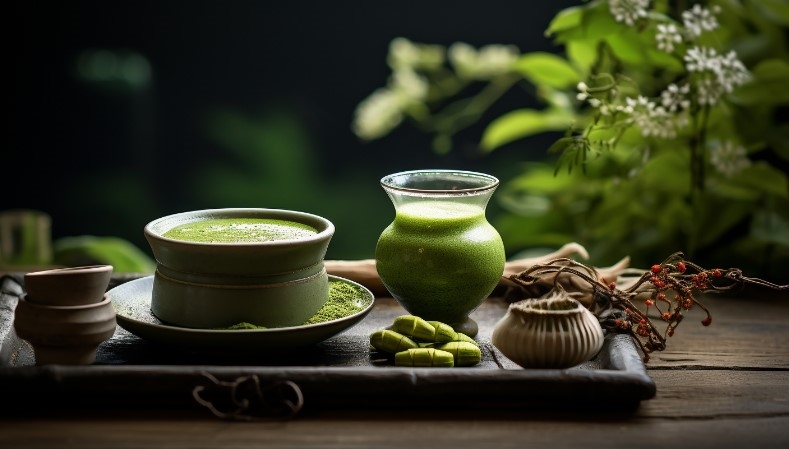Historical development and current situation of matcha tea

Matcha originated in China. In ancient China, matcha tea is called powder tea, which is made of high-quality fresh tea as raw materials and processed by steaming, rolling, drying and other technologies. The tea powder with small particle size is natural green in appearance.
According to research, in the Wei and Jin dynasties of ancient books and documents there is a record of the last tea. Jin Dynasty Du Yu in the “Fu” there are “Ling mountain only mountain, strange production bell, Jue Sheng grass, rice valley, rich soil moisture, by the dew of the sky down…… Only the beginning, foam sinks Hua floating, huan like snow, if the spring compress.” This may be the earliest ancient poem to introduce the last tea, the poem will be the last tea after brewing the scene described as “foam sinking Hua floating, like spring.” Tang and Song dynasties were the heyday of China’s feudal society and the development period of China’s late tea culture. The last tea rose in the Tang Dynasty and reached its peak in the Song Dynasty. Lu Yu, the tea sage, mentioned the last tea for the first time in the book of Tea, and talked about the process of making the last tea and the way of brewing tea. The tea is crushed with a hammer, then crushed with a roller (stone or metal), and then sifted with a basket (a two-layer sieve). The fineness of the tea is about 80 mesh. When drinking tea, first boil water in a pot, and then stir the matcha into the pot. When the water is boiled to about 80 ° C (to the fish eye bubbles), it is divided and drunk. This is a kind of artistic conception of the last tea ceremony called “meaningful jade foam” by Lu Yu, while the so-called “tilting basket of short retard steaming new leaves, white dry eye is fine to research “,” tired and tired to get thin” describes the scene of steaming green last tea production at that time.
The last tea was further developed and improved in the Song Dynasty, and became an indispensable mainstream beverage in People’s Daily life. Wang Anshi said that “Fu tea for civil use, equal to salt rice, can not be lost in a day”. Wang Zhen of Yuan Dynasty made a detailed record of the production process of steaming green tea in ancient times in Nongshu: “grain rain is the best for tea picking”; After the harvest, “the retort is steamed and cooked. After steaming, spread thinly with a basket of foil, knead it slightly with wet, bake in, evenly spread the fire to dry, do not scorch. Weaving bamboo for baking, wrapping the chopsticks and covering it, in order to collect anger “; Then, “finely grind.” This is the most complete record of the production process of steaming green last tea in ancient China. Tang, Song and even before the middle of the Ming Dynasty, the last tea should be produced by this method. From the middle and late Ming Dynasty onwards, bud and leaf tea (i.e., brewed tea or loose tea) became the dominant direction of consumption and production, leading to the gradual disappearance of final tea.
Matcha is a kind of tea powder, but it is different from the ordinary green tea powder sold in the general market. In Japan, matcha is called “jade in tea”, which means “its color is as green as jade”. The modern matcha production process is always carried out at a lower temperature, which preserves the active ingredients in the tea well. Matcha can not only be eaten directly, but also be used as a natural and healthy new food additive in food. At present, matcha has been used in ice cream, yogurt, milk, moon cakes, candy, jelly, beverages, health food and other high-end food fields. Not only that, matcha can also be used in the production of pharmaceutical intermediates, cosmetics and other products. According to the report, 70 percent of matcha in the domestic market is used as a food additive, 20 percent is used in beverage production and tea ceremonies, and 10 percent is used in the pharmaceutical and cosmetic industries. With the deepening of the communication of tea culture in the world, the health care function of tea is gradually revealed, and the ancient product of matcha has aroused new vitality. Matcha consumption craze is gradually rising around the world, and a large number of processed foods using matcha as raw materials have emerged, such as “Matcha ice cream” launched by Haagen-Dazs, “Matcha yogurt” launched by Shanghai Bright Dairy, “Matcha Mousse” by Yuanzu Cake, “Matcha smoothie” by Xianzlin, “Matcha ice fruit” and “Matcha mooncake” by Pizza Hut, etc. Many urban youth also consume matcha food as a fashion.
Backvita
